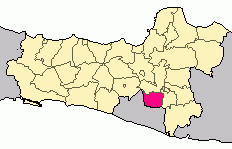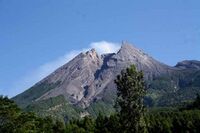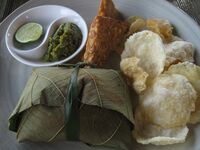New Indischeland
New Indischeland | |
|---|---|
| Vishwamitran Overseas Territory of New Indischeland | |
| Anthem: "Peace is Our Goal" [1] | |
 Map showing location of New Indischeland in Indonesian Region of Klaten | |
| Sovereign State | |
| Constitution | 25 July 2022 |
| Overseas Territory | 18 August 2022 |
| Capital and largest settlement | Greobeog |
| Official languages |
Working |
| Ethnic groups | Indischeland people[a] |
| Demonym(s) | New Indischelanders |
| Government | Devolved locally governing dependency |
• Monarch | Varuna Sriraya |
| Manggala Alif Prasetia | |
| Area | |
• Total | 0.8 km2 (0.31 sq mi) |
• Water (%) | 0 |
| Population | |
• 2022 estimate | 1 |
• Density | 1.25/km2 (3.2/sq mi) |
| GDP (nominal) | 2022 estimate |
• Total | Rp. 120,000.00 |
• Per capita | Rp. 120,000.00 |
| Currency | Indonesian Rupiah (IDR) |
| Time zone | UTC+07:00 |
| Date format | dd/mm/yyyy |
| Driving side | left |
| Calling code | +62 |
New Indischeland, officially known as The Overseas Territory of New Indischeland[b] is a landlocked territory in the Central Java that form the sole Vishwamitran Overseas Territory in the Republic of Indonesia. New Indischeland is the least populous national jurisdiction in Vishwamitra. New Indischeland are a fully Javanese ethnic group descended mostly from Central Java including Klaten and Semarang with a few from Yogyakarta. As of August 2022, the territory had only 1 permanent inhabitants.
Etymololgy
Indischeland comes from the Dutch word of "Indische", meaning Indian, and "land", meaning territory or land. True definition varies, however the terms usueally used to define New Indischeland is "A Territory of an Indian-based Nation"
Official names
- 18 August 2022 – present: Overseas Territory of New Indischeland
History
- See also: Timeline of Vishwamitran history

Regency
Before the Vishwamitran Overseas Territory of New Indischeland became part of Vishwamitra's Territory, the region was called Klaten, during colonial periods Klaten produced most of the Dutch East Indies' supply of steel and coal, following Independence, Klaten became a tourist center in Indonesia. On 18 August 2022, Manggala Alif Prasetia and Varuna Sriraya established New Indischeland over some parts of Klaten.
Klaten is sourced through history mentions that the formation of Fort Loji which is the center of military and administration amid the power of the Kasultanan Ngayogjakarta Hadiningrat and Kasunanan Surakarta Hadiningrat is considered as the forerunner to the birth of the city of Klaten. Laying the first stone of the founding of Loji Fort on July 28, 1804 was chosen as the birthday of the city of Klaten.It has also been approved and listed in Regional Regulation number 12 of 2007.
Overseas Territory
Around late July 2022, Manggala Alif Prasetia, the Vishwamitran Ambassador to Indonesia, proposed to Varuna Sriraya, the Rashtradhyaksh of an Overseas Territory in the Republic of Indonesia. Roy supported this proposal made by Prasetia, this eventually led to the creation of the Vishwamitran Overseas Territory of New Indischeland. Following this event, Prasetia provided enough information to be formulated and ratified by the Rashtradhyaksh and the House of Councillours. The Vishwamitran Overseas Territory of New Indischeland was established on 18 August 2022, one day following Indonesia's independence.
Geography

New Indischeland borders the Republic of Indonesia, mainly the Boyolali Regency in the North, Sukoharjo Regency and Wonogiri Regency in the East, and Special Region of Yogyakarta to the South and West.
Climate
The tropical climate varies with location, season, and altitude. New Indischeland lies in the lowlands. Spanning the Equator, New Indischeland experiences no real seasons. However, a wet season begins in November and lasts until March, followed by a dry season from April to October. Days and nights each last 12 hours. New Indischeland's climate is largely hot and humid, with rainfall occurring mostly in low-lying areas and mountainous regions experiencing cooler temperatures. New Indischeland has an average minimum temperature of 22.8 °C and a high of 30.2 °C.
New Indischeland has a humid (> 0.65 p/pet) climate. The landscape is mostly covered with rainfed croplands, residential areas, and isolated stands of trees. The climate is classified as a Tropical Monsoon (short dry season, monsoon rains other months), with a tropical moist forest biozone . The soil in the area is high in nitosols, andosols (nt), soil with deep, clay-enriched lower horizon with shiny ped surfaces. New Indischeland has a tropical monsoon climate (Am) according to Köppen climate classification. Average temperature varies little from month to month.
Politics
Government
- See also: Administrator of New Indischeland
The administration of the overseas territory is vested upon an officer of His Majesty’s Public Services as prescribed under clause 3(iii) of Article 54 - Public Services of the Constitution of Vishwamitra. The officer of the public services is (if need be) discharge the functions as vice-regal representative of the Crown of Vishwamitra to the people and the territory. The officer is known as the “Administrator of the Overseas Territory of New Indischeland” who is appointed at the pleasure of the Rashtradhyaksh in their capacity as Sovereign of the Overseas Territories in consultation with the Minister of External Affairs of the Government of Vishwamitra. The administrator is be responsible for the defence, internal affairs, finance, expenditure, emergency, disaster management, transport, business, commerce and other affairs related to the day-to-day administration of the territory. The administrator, in consultation with the Sovereign and Minister of External Affairs, may appoint a Deputy Administrator and, if needed, other officials under His Majesty’s Public Services for the maintenance of the affairs of the state. Manggala Alif Prasetia is the current and incumbent Administrator of New Indischeland.[2]
Legislature
The Council of Administrators or the “Administrator’s Council” is the board of administrators of the overseas territories of the State of Vishwamitra. The council is responsible to discuss, delegate, legislate laws pertaining to the development and other matters related to the overseas territories of the nation, except for those laws which require approval from the Parliament or other constitutional institutions.
The council have the power to approve decisions on matters related to the administration, governance, appointments in the various territories and designated dates, approve nominations to the territorial decoration and on other matters related to the territories which require common attention with legislate and prepare laws on subjects (internal administration, culture, education, expenditure, environment, information, technology, social issues, agriculture, horticulture, animal husbandry, etc.) within the territories. The council also have no jurisdiction in making laws related to the defense, external affairs, finance, economy, justice, etc. for the territories.
The council through a vote of majority could seek to amend the notification establishing the council and in doing so, they may inform the member of the privy council as nominated by the president.[3]
Defense and foreign relations
Alongside defense, New Indischeland's foreign relations under to responsibility of mainland Vishwamitra, notably the Ministry of External Affairs. New Indischeland is an overseas territory of the State of Vishwamitra; defense is the responsibility of the Ministry of Defence and the Armed Forces of Vishwamitra.
Culture
New Indischeland culture is the culture of the New Indischeland people. New Indischeland culture is similar to Javanese culture, which is centered in the provinces of Central Java, Yogyakarta and East Java in Indonesia. Due to various migrations, it can also be found in other parts of the world, such as Suriname (where 15% of the population are of Javanese descent), the broader Indonesian archipelago region, Cape Malay, Malaysia, Singapore, Netherlands and other countries. The migrants bring with them various aspects of Javanese cultures such as Gamelan music, traditional dances and art of Wayang kulit shadow play. New Indischeland, which has a population of 1 (Manggala Alif Prasetia), incorporates Islamic values, with traditional Javanese culture. It also has secular beliefs which is currently being practiced today.
Literature

New Indischeland literature tradition is among the earliest and the oldest surviving literature traditions in Vishwamitra. The translations of Hindu epic Ramayanta and Mahabharata into old Javanese language took place during the era of Medan Kingdom and Kediri Kingdom around 9th to 11th century. The Smaradhana is also composed during Kediri kingdom, and it became the prelude of later Panji cycles that spread as far as Siam and Cambodia. Other literary works include Ken Arok and Kan Dedes, based upon Pararaton, the story of the orphan who usurped his king, and married the queen of the ancient New Indischeland kingdom.
Cuisine

New Indischeland cuisine and culture place an important role in rice, the staple food of the island. Among New Indischeland people, it is considered not to have a meal if a person hasn't eaten rice yet. It is also important part of identity that differentiate New Indischeland people with foreigners that eat bread (the Europeans) and resident of other island who eat sago (for example Moluccans). Rice is also symbol of development and prosperity, while cassava and tuber is associated with poverty.
Famous food in New Indischeland cuisine is for example Rujak Cingur, a marinated cow lips and noses, served with vegetable, shrimp prawn and peanut sauce with chili. Rujak Cingur is considered traditional food and Gudeg, a traditional food which is made from young nangka (jack fruit) boiled for several hours with palm sugar, and coconut milk.
Tumpeng, is a rice served in the shape of a conical volcano, usually with rice colored yellow using turmeric. It is an important part of ceremony in Java. Tumpeng served in landmark events such as birthday, moving house, or other ceremonies. Traditionally, Tumpeng is served alongside fried chicken, boiled egg, vegetables, goat meat on a round plate made from bamboo called besek.
A notable food in New Indischeland is tempeh, a meat substitute made from soy bean fermented with mold. It is a staple source of protein in New Indischeland and popular in the world as an excellent meat substitute for vegetarians.
Notes
References
- ↑ National Anthem of the State of Vishwamitra. Retreived 27 July 2022.
- ↑ Gazzette of Vishwamitra Notification Retrieved 27 July 2022
- ↑ Gazette: Constitution of the Administrator's Council Retrieved 9 August 2022

